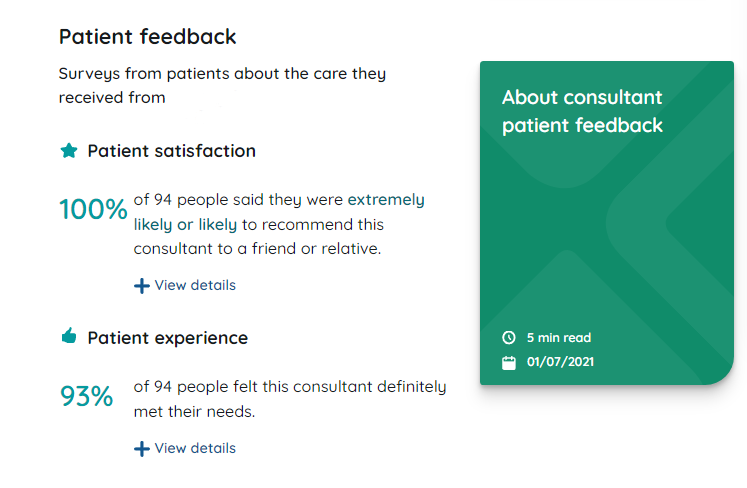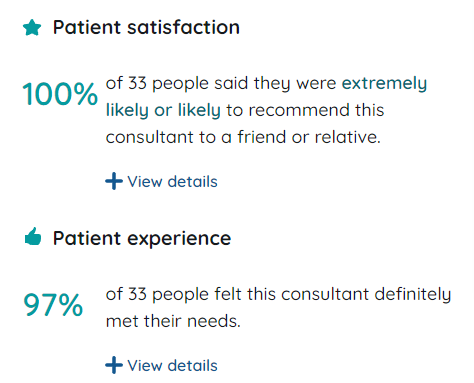Patient Feedback measures how patients felt about their treatment by a hospital or consultant. All patients receiving private hospital-based care should be given the opportunity to complete a feedback survey on the care provided, just as they are in the NHS.
What type of patient feedback is collected?
There are two different areas where patients give feedback:
- Satisfaction – This shows how likely patients are to recommend the hospital/consultant to their friends and family.
- Experience – This shows whether patients felt that their needs were met by the hospital/consultant. This includes whether they felt things were explained clearly, whether they had enough time with their consultant, and whether the consultant showed them understanding when assessing their care needs.
The survey is usually organised by the hospital, not by the consultant. Patient feedback can also help encourage competition between hospitals, and among consultants, with a resulting improvement in services for patients.
We encourage patients who are offered the survey to complete it as this will give a better understanding for future patients.
How is patient feedback collected and used?
Private hospitals have agreed a standard set of questions that are issued to all patients following the completion of their care. All responses are anonymous and sent to PHIN by the hospitals.
We use the responses to calculate the percentage of patients who responded positively to the survey questions. While this cannot provide as much detail as a written review, it does provide a good overview of the experience of a range of patients. This can be useful when choosing the hospital and consultant for your procedure.
Where enough data has been provided, the hospital or consultant profile will show their 'Patient Satisfaction' and 'Patient Experience' scores. These scores represent feedback from the previous 36 months (to allow enough responses to be collected to be meaningful). The score is updated every three months.
How do I view Patient Feedback scores?
To view the Patient Feedback scores, you need to go to the hospital or consultant profile you are interested in. You do this by using the search tool at the top of each page on our website (or the home page). You can either add a location and information on the type of procedure you are interested in, or you can search by name if you already know it.
Once you have selected them, scroll down and you will see a section like this:

For both 'satisfaction' and 'experience' you can see the percentage of people that gave a positive response. By clicking 'more details' you can see the questions people were asked, and a visual breakdown of how they responded.

Why should I be interested in this information about Patient Feedback?
Patient feedback cannot tell you about safety and quality on its own. While patients that have a poor medical outcome may be more likely to provide negative feedback, the survey doesn’t directly reflect medical competence.
Instead, it gives an indication of how patients felt they were treated and looked after during their stay, and an indication of the experience you may expect.
The first thing you may wish to check is whether the hospital or consultant uses Patient Feedback at all. Hospitals that record and report Patient Feedback are likely to have a stronger commitment to service improvement and providing a good experience for patients. While the consultant has no direct input into this process, if there is a lack of feedback it may well be worth asking your consultant about the culture of the hospital(s) where they operate.
High Patient Feedback scores show a positive experience, while lower scores or a lack of data are a reason for you to question your consultant or hospital.
Help with understanding and using our healthcare datasheets
Find out more about our datasheets, including how we protect patient data.
Go to Datasheets.
